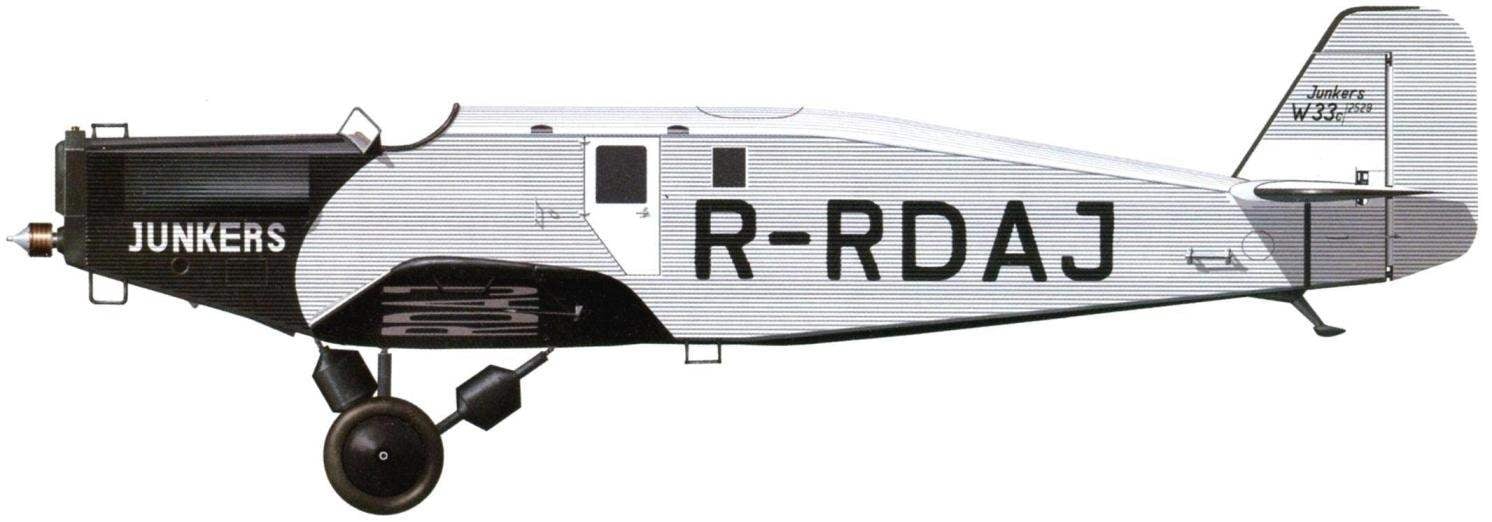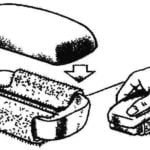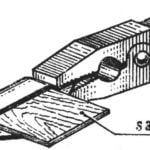 In the first years after the Civil war, the Soviet civil aviation monopoly reigned all-metal aircraft of the German production. “Ukrvozduhput” preferred products of the company “Dornier” and “Dobrolet” and “Zakavia” purchased the aircraft from company “Junkers”. Single-F13 for a long time was the main “workhorse” on the Soviet civil lines, and military transport. Following this, albeit in significantly smaller quantities, began to acquire W33.
In the first years after the Civil war, the Soviet civil aviation monopoly reigned all-metal aircraft of the German production. “Ukrvozduhput” preferred products of the company “Dornier” and “Dobrolet” and “Zakavia” purchased the aircraft from company “Junkers”. Single-F13 for a long time was the main “workhorse” on the Soviet civil lines, and military transport. Following this, albeit in significantly smaller quantities, began to acquire W33.
W33 was designed under the direction of G. Pohlmann. On the basic constructive decisions, he reminded F13. This, too, was a single-engine all-metal cantilever monoplane with corrugated lining, an open cockpit and fixed landing gear. Wingspan took the same as F13, but the outlines of his plan have changed. Since the machine was considered cargo and mail, not passenger, the fuselage done already and longer. Windows in the sides eliminated. The loading was carried out through the door on the left side and a hatch in the ceiling. W33 had dual control, although the crew consisted of the pilot (left) and flight engineer (right). The aircraft was equipped with inline four-cylinder engine water-cooled Junkers L5, 310 HP
For W33 envisaged three variants of the chassis – wheeled, ski and float. In the latter case, the machine was mounted on two metal float. I wonder what the Germans were doing the floats are not made of aluminium, and magnesium alloy “electron”.
The prototype W33 assembled first in the float version. The first flight was made by pilot Zimmerman 17 June 1926, He took off from the Elbe near Dessau. In July, two float prototype took part in the competition of seaplanes in warnemünde. One of them eventually took second place. The first sample, named “Leopoldshafen”, later moved to the wheels.
Serial production of W33 at the factory in Dessau launched in 1927 On serial machines, the upper part of the fuselage became more flat. In the same year on the new “Junkers” set ten world records for range and flight duration.

The prototype W33 on wheels, 1926

W33 with weapons, built at Limhamn Chinese order

PS-4 registration designation L-42 was manufactured in Irkutsk and had its own name “bodaybinskiy Shakhtar”. He is a little different from the machines of German manufacture

Л1402 – PS-4, made by the Moscow factory No. 89. He was distinguished by a closed cockpit and an improved heating system
The car was produced in a large number of options. Planes on wheels designated W33L on two metal floats – W33D. The latter had two floats – with a displacement of 2200 2850 l and L. the latter was intended for aircraft of the later series (they were heavier). They also mounted an enlarged rudder, and sometimes also a small ventral keel.
A large part of the W33 got the motors L5, but there were also L2 (260 HP), L5G (425 HP) BMW Va (355 HP). The aircraft later series did the small Windows in the cargo cabin (their location and size changed), but in the end – closed lamp pilot’s cabin. Of the cars had a passenger cabin with six beds, with Windows on the sides. This was, for example, training modification W33ge. Occasionally, in the North of the aircraft supplied by heating the air heater; cab and cargo compartment air is heated by the exhaust gases. At the right side on top on the outside was a pipe duct.
In April 1928 the car with additional fuel tanks, named “Bremen”, made a nonstop flight from Ireland to the island of Grinell off the coast of Canada. The crew stayed in the air for 37 hours. Now this plane is on display in the hall of the airport in Bremen. In September of the same year, W33 “Europe” flew to Japan, breaking the 14 500 km.
On W33 has held a number of interesting experiments. In particular, in June 1929, it tried take off with rocket boosters, and in November 1930 was refueling in the air.
In may 1930 W33 collected at the plant “AB Flygindustri” in Limhamn, in Sweden – the local branch of the “Junkers”. The fact that the Treaty of Versailles forbade Germany to build military aircraft. So the finished units are transported to Sweden and then collected by adding military equipment.
Firm “Junkers” received an offer from the government of the Chinese province of Shanxi to make six W33 with weapons. The prototype of this modification was built in Limhamn. The aircraft was carrying two synchronous machine gun MG 08/15, firing forward, and one MG 15 in the turret in the rear fuselage. All the guns had a caliber of 7.9 mm.
This car was secretly tested in Germany in travemünde.
In Limhamn was doing and civil W33. Two of them are marked W33J, exported to Japan. They had already closed the cockpit. In 1932, on one of these machines, the Japanese tried to fly nonstop to the USA, but the “Junkers” had disappeared over the ocean.
For the Swedish air force where he also produced six cars, designated Trp2. They were used as transport, medical and rescue until the mid-1950s In June 1952, “Junkers” was in the search of the crews of two Swedish reconnaissance aircraft shot down by Soviet fighters off the coast of the Baltic. Only the Swedes have produced about 30 cars of various modifications.
In Germany at the factory in Dessau W33 was built prior to 1934, All collected 198 copies.
Civil aircraft of this type operated in Brazil, Germany, Canada, Colombia, Iceland, Sweden and Japan. A few cars entered the air force of Argentina and Iran. Colombian “Junkers” were involved in an armed conflict with Peru in 1932 – 1933 the Only Ethiopian W33 involved against the Italians in 1935 – 1936 After the establishment of the German Luftwaffe for a number of cars served in training units.

Plane L-31 in service on route Irkutsk – Yakutsk

Junkers W33b1 of issue 1926

Float W33D, who worked on the Irkutsk – Yakutsk, taxis to the Marina

Float W33D on the New Earth

Aircraft N5 Department of air service house in Tiksi, 1935 Machine is installed on the ski
W33 was used in the Soviet Union. The first three cars of Dobrolet arrived in Moscow in November-December of 1928 They were bought instead of the originally ordered G. 24, who wanted to use in Yakutia. The planes were equipped with float landing gear and extended from the bottom of the rudder. In winter, they coaches would simply be fitted on the ski.
Two cars were sent to Irkutsk for flights to Yakutsk and Bodaybo. From February 1929 they flew Otto Kalvitsa and Mauritius Slepnev. Airplanes mounted on skis, taking off from the frozen river and sat as well. Flight to Yakutsk and back then it took two weeks, and sometimes more – because of bad weather. In winter reaches – 60 °C. When the water is free of ice, the cars moved on the floats.
In July 1929, Kalvitsa one of them was transported by steamer from Vladivostok to the Bay of Lawrence. From there on W33, he surveyed part of the coast of the Arctic ocean, continuing the unfinished work of the expedition on the “shaft” of the “Soviet North”, broken by storm in kolacinski lip a year earlier. Kalvitsa flew 5450 km, when on August 18 near the village of Bulun, the engine started shaking. After landing, the motor started on earth, but came off the screw together with the toe of the crankshaft. Further W33 sailed South on the barge, and the crew was evacuated by another aircraft.
In 1929, he purchased another W33. With the same machine, bought earlier, he took part in the search for the American pilots Eielson and Borland ides from the ‘ missing persons, searching for icebound ship “Nanook”. One was piloted W33 Mauritius Slepnev, and the other Victor Galyshev. They found the wreckage of an American plane and brought the bodies of the crew members. Slepnev took them to Nome, Alaska.
In early 1930, received from Germany another five W33. Six cars were based in Irkutsk, serving the line to Yakutsk, Bodaibo; three more were in Khabarovsk, to communicate with the island.
From February 1930 formerly independent airlines joined the “Dobrolet”, in November, converted into a single all-Union Association – the GVF.
In 1930, with the German aircraft have been five accidents and disasters. Of the three “Junkers”, who flew to Sakhalin, the two were quickly defeated. Pilot Kapralov because of motor failure in flight landed on the forest. He, his mechanic and three passengers survived and the plane was hopelessly destroyed. 10 Jul pilot Semenenko due to heavy fog was over the Amur river is very low and accidentally hooked up the water float. Victims, fortunately, not happened again.

The most famous episode of the Soviet aircraft-176. In March 1930, Otto Kalvitsa went from Yakutsk up the Lena. He was supposed to deliver a radio operator with the station Zhigansk and medicines – Bulun. The medicines were intended for detachment of the Cheka, to suppress unrest among local residents and have suffered losses in clashes with them. But on 7 March near the village of Sangar sudden gust of wind put the car on the nose. Not tied belts mechanic Leonhard fell from the open cockpit. “Junkers” fell on the ice and the fuselage broke into two parts. Pilot, flight engineer and radio operator were killed. 9 September of the same year, was a Soviet aircraft-441, which flew a crew of pilot, Komarenko. Both cars were written off, but the wreckage was taken to Irkutsk. There, workshops were rebuilt, that is actually rebuilt using a small number of good parts from the original.
Having the necessary experience in repair work, in Irkutsk, took up their own production W33. In the second half of 1932 under the leadership of Nikolai Rogozhin here produced its first car, the designation Л42. It is slightly different from the original only by the number and shape of the cab Windows. The engine was the same – L5, imported from Germany. Then they collected two more Soviet “Junkers” that have received designation Л735 and Л752. Cabin crews made closed.
However, the issue in Irkutsk could not reimburse cancellation W33 due to accidents, as over the 1931 lost three aircraft during the first half of 1932-two more, and one of the cars was a new edition in 1932, This means that at this time in Germany bought at least one more W33.
In 1934 a batch of similar aircraft produced Zavod No. 89 at Moscow. Well-known aviation historian Vadim Shavrov writes about seven “Junkers” made in Irkutsk, and ten in Moscow. But apparently he includes in the total score and recovered the car. By this time the German W33 was built according to the new notation became known as PS-3, and the Soviet SS-4. They all served in Siberia and the far East.
So, Irkutsk Л735 and Л752 in 1932 -1933, he flew at the line along the Lena river in the summer on floats, in winter – skiing. Moscow Л1402, which bore the name “Soviet Yakutia” (according to other sources -“10 years of the Yakut ASSR”), surpassed in Irkutsk pilot Mikhailik. June 5, 1934 this machine with the pilot Garanin arrived in Yakutsk. 7 July staged air riding “drummers” – the best workers. In August of the same year in Yakutsk was also Л1415 new and old Л42.
In 1934 two “Junkers” took part in the rescue of the members of the expedition on the icebreaking steamship “Chelyuskin”, February 13 crushed by ice off the coast of Chukotka. People were on a drifting ice floe on which the camp was built. To get to them could only aircraft. Just to Chukotka sent 18 aircraft. Among them were two SS-4 in Irkutsk production, piloted by Victor Malyshevym and Ivan Doronin, who went in the way from Khabarovsk. At an intermediate landing in Kamenskoye Doronin broke the chassis, but it was repaired in one day. Later Galysheva failed benzarone, and he was never able to get to the side. Doronin also made one flight. During takeoff from the ice again he damaged the landing gear. It was hastily repaired, but to take off with a large number of people, the pilot decided not to and took only two passengers. In the run-up chassis gave way again, but Doronin has managed to break away from the ice. He masterfully landed in Vankarem on one ski. In the same way as other pilots, taking out people from an ice floe, Doronin received the gold Star of Hero of the Soviet Union.
Basic data W33 (with motor L5) and the PS-4

Since the end of 1932 W33 exploited also Management of air service goose — polar aviation. At first it was one such plane, H5 (probably imported), then, in January 1935, it added Н62 and Н63 (made by factory No. 89). 3 Mar 1935 N5 and Н62, manned by Malyshevym and Neranena, landed on the ice of the lake near the village of Sangar in Yakutia. It was an intermediate phase of exploration of the route Yakutsk – Tiksi, which later in the summer began to fly regularly. All three Junkers house was listed for Lensk air group, the aircraft which flew mostly along the Lena river and in its vicinity. Usually by the end of autumn machine house was returning to base in Krasnoyarsk, where he passed the necessary repairs at a local factory. It is known that in 1935 there visited H5, and in 1936, N5 and Н63.
In the second half of the 1930s, Eastern Siberia was the only area of application of the “Junkers”. Them some time exploited the line of Verkhneudinsk – Ulan-Bator.
One of the documents says about the transfer of one W33 gift of Mongolia.
But a few others claim that it was an older se-13 (F13).
The number of cars in East-the Siberian management of civil air fleet was gradually reduced due to wear and accidents. Apparently, the German aircraft production in 1936 General left. In any case, lists GU GVF after 1937, was the SS-4. By the beginning of 1939 there were nine in March 1940 – five, but serviceable was considered to be the only one. On 1 December 1940 about them is not mentioned, however, the report of the Yakut air group in 1941 the SS-4 is present. However, nowhere is it written that he flew, not just stood waiting for disposal. Perhaps this is one of the former aircraft house. The fact that in April 1941 Lena house air group disbanded, and her technique for the most part gave the Yakut formations GVF. She also got some of the planes East-the Siberian management of CAF.
All purchased by the Soviet Union and the W33 the PS-4 local Assembly was only used in civil aviation. But in the Soviet Union flew one war machine of this type, but it was not Soviet, and German. This W33 1929 operated in Lipetsk, where in agreement with the Reichswehr housed German aircraft training and test center. This “Junkers” were used as transport aircraft. As all the art of the Lipetsk center, it had no red stars, no black crosses – only Board room. After coming to power of Hitler, the centre was closed. At the end of August 1933 the aircraft W33, К47 and A38 flew to Moscow and then on the track “Derulyufta” in Koenigsberg.
V. KOTELNIKOV



